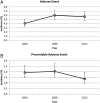How effective are patient safety initiatives? A retrospective patient record review study of changes to patient safety over time
- PMID: 26150548
- PMCID: PMC4552927
- DOI: 10.1136/bmjqs-2014-003702
How effective are patient safety initiatives? A retrospective patient record review study of changes to patient safety over time
Abstract
Objectives: To assess whether, compared with previous years, hospital care became safer in 2011/2012, expressing itself in a fall in preventable adverse event (AE) rates alongside patient safety initiatives.
Design: Retrospective patient record review at three points in time.
Setting: In three national AE studies, patient records of 2004, 2008 and 2011/2012 were reviewed in, respectively, 21 hospitals in 2004, 20 hospitals in 2008 and 20 hospitals in 2011/2012. In each hospital, 400, 200 and 200 patient records were sampled, respectively.
Participants: In total, 15 997 patient admissions were included in the study, 7926 patient admissions from 2004, 4023 from 2008 and 4048 from 2011/2012.
Interventions: The main patient safety initiatives in hospital care at a national level between 2004 and 2012 have been small as well as large-scale multifaceted programmes.
Main outcome measures: Rates of both AEs and preventable AEs.
Results: Uncorrected crude overall AE rates showed no change in 2011/2012 in comparison with 2008, whereas preventable AE rates showed a reduction of 45%. After multilevel corrections, the decrease in preventable AE rate in 2011/2012 was still clearly visible with a decrease of 30% in comparison to 2008 (p=0.10). In 2011/2012, fewer preventable AEs were found in older age groups, or related to the surgical process, in comparison with 2008.
Conclusions: Our study shows some improvements in preventable AEs in the areas that were addressed during the comprehensive national safety programme. There are signs that such a programme has a positive impact on patient safety.
Keywords: Chart review methodologies; Hospital medicine; Medical error, measurement/epidemiology; Patient safety.
Published by the BMJ Publishing Group Limited. For permission to use (where not already granted under a licence) please go to http://group.bmj.com/group/rights-licensing/permissions.
Figures



Comment in
-
Safety in healthcare is a moving target.BMJ Qual Saf. 2015 Sep;24(9):539-40. doi: 10.1136/bmjqs-2015-004403. Epub 2015 Jul 6. BMJ Qual Saf. 2015. PMID: 26150547 Free PMC article. No abstract available.
Similar articles
-
Adverse events and potentially preventable deaths in Dutch hospitals: results of a retrospective patient record review study.Qual Saf Health Care. 2009 Aug;18(4):297-302. doi: 10.1136/qshc.2007.025924. Qual Saf Health Care. 2009. PMID: 19651935
-
Is researching adverse events in hospital deaths a good way to describe patient safety in hospitals: a retrospective patient record review study.BMJ Open. 2015 Jul 9;5(7):e007380. doi: 10.1136/bmjopen-2014-007380. BMJ Open. 2015. PMID: 26159451 Free PMC article.
-
Incidence of adverse events in Sweden during 2013-2016: a cohort study describing the implementation of a national trigger tool.BMJ Open. 2018 Mar 30;8(3):e020833. doi: 10.1136/bmjopen-2017-020833. BMJ Open. 2018. PMID: 29602858 Free PMC article.
-
Changes in adverse event rates in hospitals over time: a longitudinal retrospective patient record review study.BMJ Qual Saf. 2013 Apr;22(4):290-8. doi: 10.1136/bmjqs-2012-001126. Epub 2013 Jan 4. BMJ Qual Saf. 2013. PMID: 23293136
-
Medication-related adverse events during hospitalization: a retrospective patient record review study in The Netherlands.Pharmacoepidemiol Drug Saf. 2017 Jan;26(1):32-39. doi: 10.1002/pds.4037. Epub 2016 May 19. Pharmacoepidemiol Drug Saf. 2017. PMID: 27193415
Cited by
-
Incidence and preventability of adverse events in adult patients admitted to a Brazilian teaching hospital.PLoS One. 2021 Apr 15;16(4):e0249531. doi: 10.1371/journal.pone.0249531. eCollection 2021. PLoS One. 2021. PMID: 33857137 Free PMC article.
-
Can using the functional resonance analysis method, as an intervention, improve patient safety in hospitals?: a stepped wedge design protocol.BMC Health Serv Res. 2021 Nov 13;21(1):1228. doi: 10.1186/s12913-021-07244-z. BMC Health Serv Res. 2021. PMID: 34774048 Free PMC article.
-
Development of the Surgical Patient safety Observation Tool (SPOT).BJS Open. 2018 Apr 3;2(3):119-127. doi: 10.1002/bjs5.44. eCollection 2018 Jun. BJS Open. 2018. PMID: 29951635 Free PMC article.
-
The Harvard medical practice study trigger system performance in deceased patients.BMC Health Serv Res. 2019 Jan 8;19(1):16. doi: 10.1186/s12913-018-3839-6. BMC Health Serv Res. 2019. PMID: 30621689 Free PMC article.
-
Hospital nurses' knowledge about older patients in Turkey: a validation and comparison study.BMC Nurs. 2022 May 10;21(1):111. doi: 10.1186/s12912-022-00882-6. BMC Nurs. 2022. PMID: 35538472 Free PMC article.
References
-
- Institute of Medicine. To err is human; building a safer health system. Washington DC: National Academy Press, 2000.
Publication types
MeSH terms
LinkOut - more resources
Full Text Sources
Other Literature Sources
Medical
